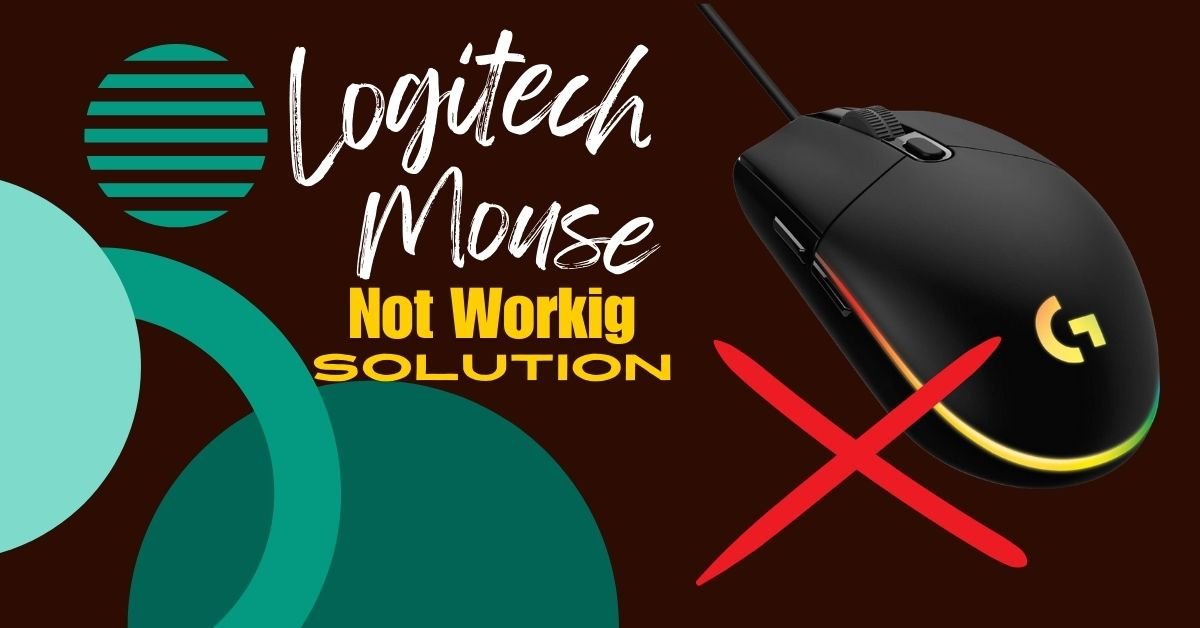Logitech Mouse Not Working? Follow these quick and simple tips to fix the issue. Works for both wired and wireless Logitech mice.Is your Logitech mouse not working? Don’t worry, it happens to many people. Sometimes, it stops moving or clicking. Maybe it’s not connecting at all. This can be frustrating, especially when you’re in the middle of work or gaming. But the good news is, fixing it is usually simple. You don’t need to be a tech expert. In this guide, you will learn quick and easy steps to make your mouse work again. Anyone can follow these steps. Let’s get started and bring your Logitech mouse back to life!
Common Reasons Why Your Logitech Mouse Is Not Working
There are several potential causes for your Logitech mouse not working. Understanding these can help you diagnose and fix the issue more efficiently. Some of the most common reasons include:
- Low Battery: If you’re using a wireless Logitech mouse, one of the first things to check is the battery. A low or dead battery is a common reason for connectivity issues.
- Driver Issues: Outdated or corrupted drivers can cause your Logitech mouse to stop working.
- Connection Problems: For wireless mice, connectivity issues with the receiver or Bluetooth can prevent the mouse from working properly.
- Hardware Malfunctions: Sometimes, the mouse itself may be defective or damaged, leading to operational issues.
- Interference: Other wireless devices or certain physical obstructions can interfere with the mouse’s signal, causing it to disconnect or lag.
How to Fix a Logitech Wireless Mouse That Is Not Working
If your Logitech wireless mouse is not working, there are several steps you can take to troubleshoot and fix the issue. Here’s a step-by-step guide:
- Check the Batteries: Start by replacing the batteries in your wireless mouse. Ensure that the batteries are inserted correctly and that they are fresh. Weak batteries often cause the mouse to malfunction.
- Reconnect the Receiver: If you’re using a Logitech mouse with a USB receiver, unplug it and then plug it back in. Make sure it’s connected to a working USB port. You can also try connecting it to a different port to rule out any port-specific issues.
- Pair the Mouse Again: For Bluetooth mice, try re-pairing the device. Go to your computer’s Bluetooth settings, remove the mouse from the list of paired devices, and then add it again.
- Reset the Connection: Some Logitech mice have a reset button. Pressing this can re-establish the connection between the mouse and the receiver.
- Update the Drivers: Outdated drivers can cause your mouse to stop working. Visit Logitech’s official website, download the latest drivers for your model, and install them.
- Test on Another Computer: To determine if the issue is with the mouse or your computer, try connecting the mouse to another device. If it works on another computer, the problem may lie with your original device’s settings or hardware.
Fixing Connectivity Issues with Your Logitech Mouse
Connectivity issues can be particularly tricky, especially with wireless mice. Here are some targeted solutions to fix connectivity problems:
- Reduce Interference: If you have other wireless devices nearby, try moving them away from your mouse and receiver. Microwaves, wireless routers, and other Bluetooth devices can cause interference.
- Use a USB Extension Cable: Sometimes, the mouse’s signal might not reach the receiver properly. Using a USB extension cable to bring the receiver closer to the mouse can help.
- Check for Obstructions: Make sure there are no physical obstructions between the mouse and the receiver. Metal objects, in particular, can block the signal.
- Reboot Your Computer: Sometimes, simply restarting your computer can resolve connectivity issues, especially after a system update.
Logitech Mouse Not Working After Windows 10 Update? Here’s How to Fix It
Windows updates can sometimes cause drivers to become outdated or incompatible, leading to your Logitech mouse not working. If your mouse stopped working after a Windows 10 update, here’s what you can do:
- Roll Back the Update: If the mouse issue started immediately after a Windows update, you might consider rolling back the update. Go to your settings, find the update history, and uninstall the latest update.
- Reinstall the Drivers: Visit the Device Manager, find your mouse under “Mice and other pointing devices,” right-click, and choose “Uninstall device.” Then, restart your computer, and Windows should reinstall the correct drivers.
- Update the Drivers Manually: Sometimes, the automatic driver update doesn’t work properly. Visit the Logitech website, download the latest driver for your model, and install it manually.
- Use a System Restore Point: If you have System Restore enabled, you can roll back your computer to a point before the update was installed. This can often resolve driver-related issues.
Solving Logitech Mouse Issues on Mac
If your Logitech mouse is not working on a Mac, the troubleshooting steps can differ slightly from those for Windows. Here’s how you can fix Logitech mouse issues on macOS:
- Check the System Preferences: Go to System Preferences > Bluetooth and ensure your mouse is connected. If it isn’t, try reconnecting it.
- Update macOS: Sometimes, updating your macOS can fix compatibility issues with peripherals like a Logitech mouse. Make sure your system is running the latest version of macOS.
- Reset the Bluetooth Module: On Mac, you can reset the Bluetooth module by pressing Shift + Option while clicking the Bluetooth icon in the menu bar. This will give you the option to reset and re-establish connections.
- Use USB Over Bluetooth: If you’re using a Bluetooth mouse, try using a USB connection instead to see if the issue is with the Bluetooth connection itself.
- Test with Another Device: As with Windows, try connecting the mouse to another Mac to see if it works there. This can help you determine if the issue is with the mouse or the specific Mac.
How to Update Logitech Mouse Drivers
Keeping your Logitech mouse drivers up to date is crucial for maintaining its functionality. Here’s how you can update your Logitech mouse drivers:
- Automatic Updates: Windows typically updates drivers automatically. However, you can check for updates manually by going to Device Manager, right-clicking your mouse, and selecting “Update driver.”
- Logitech’s Website: For the most up-to-date drivers, visit the Logitech support website. Enter your mouse model, and download the latest drivers. Follow the installation instructions to update your drivers.
- Logitech G HUB Software: If you’re using a Logitech gaming mouse, the Logitech G HUB software can automatically keep your drivers and firmware up to date. Download it from the Logitech website and let it manage your device’s updates.
- Use a Driver Update Tool: There are several third-party driver update tools available that can scan your system for outdated drivers and update them automatically.
Logitech Mouse Cursor Not Moving: Quick Fixes
If your Logitech mouse cursor isn’t moving, it could be due to several reasons. Here are some quick fixes you can try:
- Clean the Sensor: Dust and debris can block the sensor on the bottom of the mouse, preventing the cursor from moving. Clean it with a soft, dry cloth.
- Adjust the Surface: Ensure that you’re using the mouse on a suitable surface. Reflective or transparent surfaces can interfere with the sensor. Using a mouse pad can often solve this issue.
- Check Mouse Settings: Go to your computer’s mouse settings and check the sensitivity and speed settings. If they’re too low, the cursor may move slowly or not at all.
- Reboot the Mouse: Turn the mouse off, wait a few seconds, and then turn it back on. This can reset the connection and fix the issue.
- Test with Another Computer: If the cursor still doesn’t move, try using the mouse with another computer. This can help you determine if the problem is with the mouse or your computer.
When to Consider Replacing Your Logitech Mouse
While most issues with Logitech mice can be fixed, there are times when it may be more practical to replace the mouse. Here are some signs that it might be time for a new device:
- Physical Damage: If the mouse has sustained physical damage, such as a cracked casing or broken buttons, it might be time to replace it.
- Persistent Connectivity Issues: If your mouse frequently disconnects or loses signal despite troubleshooting, the internal components may be failing.
- Outdated Technology: If your mouse is several years old, it may not support newer software or features, making an upgrade beneficial.
- Worn Out Buttons: Over time, the buttons on a mouse can wear out, leading to unresponsive clicks. If this is the case, consider replacing it.
- Upgrading for Better Performance: If you’re a gamer or use your mouse for precision tasks, upgrading to a newer model with better performance can be a worthwhile investment.
You May Also Like: SZA Before Fame: Her Life Before the Spotlight
Conclusion
A non-working Logitech mouse can be annoying, but it’s not the end. Most problems have easy fixes. Just check the battery, the USB port, or the settings. Now you know what to do. These simple steps can help your mouse work like new. Try them one by one. If it still doesn’t work, you might need a new mouse. But usually, it’s just a small issue. We hope your mouse is now working fine!
FAQs
- Why is my Logitech mouse not working even after changing the batteries?
- Ensure that the batteries are inserted correctly and that the battery contacts are clean. Also, check if the receiver is properly connected.
- How do I reset my Logitech mouse?
- Some models have a reset button. If yours does, press it to reset the connection. If not, try turning the mouse off and on again.
- Can I use a Logitech mouse on a Mac?
- Yes, most Logitech mice are compatible with macOS. Ensure you have the correct drivers or software installed.
- What should I do if my Logitech mouse is not detected by my computer?
- Try connecting the mouse to a different USB port, updating the drivers, or reconnecting the Bluetooth.
- How often should I update my Logitech mouse drivers?
- It’s a good idea to check for updates regularly, especially after major operating system updates or if you’re experiencing issues.

Evelyn White is an experienced content writer with a background in lifestyle, trends, and practical advice. With several years of writing across digital platforms, she specializes in making everyday topics accessible, informative, and engaging. Her goal is to deliver trustworthy, reader-focused content that’s both useful and easy to understand.
Discover more from Try Hard Guides
Subscribe to get the latest posts sent to your email.

